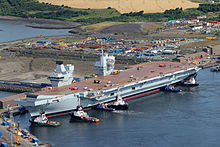
An aircraft carrier is a warship that serves as a seagoing airbase, equipped with a full-length flight deck and facilities for carrying, arming, deploying, and recovering aircraft. Typically, it is the capital ship of a fleet, as it allows a naval force to project air power worldwide without depending on local bases for staging aircraft operations. Carriers have evolved since their inception in the early twentieth century from wooden vessels used to deploy balloons to nuclear-powered warships that carry numerous fighters, strike aircraft, helicopters, and other types of aircraft. While heavier aircraft such as fixed-wing gunships and bombers have been launched from aircraft carriers, these aircraft have not landed on a carrier. By its diplomatic and tactical power, its mobility, its autonomy and the variety of its means, the aircraft carrier is often the centerpiece of modern combat fleets. Tactically or even strategically, it replaced the battleship in the role of flagship of a fleet. One of its great advantages is that, by sailing in international waters, it does not interfere with any territorial sovereignty and thus obviates the need for overflight authorizations from third-party countries, reduces the times and transit distances of aircraft and therefore significantly increases the time of availability on the combat zone.

A carrier battle group (CVBG) is a naval fleet consisting of an aircraft carrier capital ship and its large number of escorts, together defining the group. The CV in CVBG is the United States Navy hull classification code for an aircraft carrier.
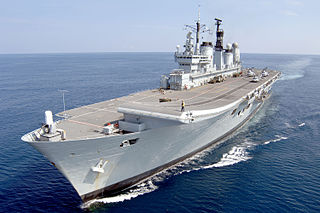
The Invincible class was a class of light aircraft carrier operated by the Royal Navy. Three ships were constructed: HMS Invincible, HMS Illustrious and HMS Ark Royal. The vessels were built as aviation-capable anti-submarine warfare (ASW) platforms to counter the Cold War North Atlantic Soviet submarine threat, and initially embarked Sea Harrier aircraft and Sea King HAS.1 anti-submarine helicopters. With cancellation of the aircraft carriers renewal programme in the 1960s, the three ships became the replacements for Ark Royal and Eagle fleet carriers and the Centaur-class light fleet carriers, and the Royal Navy's sole class of aircraft carrier.

Rosyth is a town in Fife, Scotland, on the Firth of Forth. Scotland's first Garden City, the town is located 3 miles south of Dunfermline city centre and 10½ miles northwest of Edinburgh city centre.

The Queen Elizabeth-class aircraft carriers of the United Kingdom's Royal Navy consists of two vessels. The lead ship of her class, HMS Queen Elizabeth, was named on 4 July 2014 in honour of Elizabeth I and was commissioned on 7 December 2017. Her sister ship, HMS Prince of Wales, was launched on 21 December 2017, and was commissioned on 10 December 2019. They form the central components of the UK Carrier Strike Group.

HMS Queen Elizabeth is the lead ship of the Queen Elizabeth class of aircraft carriers and the Fleet Flagship of the Royal Navy. Capable of carrying 60 aircraft including fixed wing, rotary wing and autonomous vehicles, she is named in honour of the first HMS Queen Elizabeth, a World War I era super-dreadnought, which in turn was named after Queen Elizabeth I. The carrier Queen Elizabeth carries her namesake ship's honours, as well as her Tudor rose-adorned crest and motto.

HMS Prince of Wales (R09) is the second Queen Elizabeth-class aircraft carrier of the Royal Navy. Unlike most large aircraft carriers, Prince of Wales is not fitted with catapults and arrestor wires, and is instead designed to operate STOVL aircraft; the ship is currently planned to carry up to 48 F-35B Lightning II stealth multirole fighters and Merlin helicopters for airborne early warning and anti-submarine warfare, although in surge conditions the class is capable of supporting 70+ F-35B. The design emphasises flexibility, with accommodation for 250 Royal Marines and the ability to support them with attack helicopters and troop transports up to and larger than Chinook size.
In the Royal Navy and other navies of Europe and the Commonwealth of Nations, ships are identified by pennant number. Historically, naval ships flew a flag that identified a flotilla or type of vessel. For example, the Royal Navy used a red burgee for torpedo boats and a pennant with an H for torpedo boat destroyers. Adding a number to the type-identifying flag uniquely identified each ship.
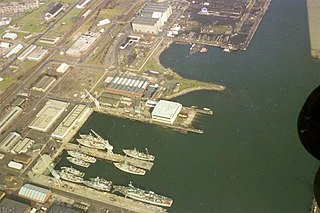
Rosyth Dockyard is a large naval dockyard on the Firth of Forth at Rosyth, Fife, Scotland, owned by Babcock Marine, which formerly undertook refitting of Royal Navy surface vessels and submarines. Before its privatisation in the 1990s it was formerly the Royal Naval Dockyard Rosyth. Its primary role now is the dismantling of decommissioned nuclear submarines. It is also the integration site for the Royal Navy's newest aircraft carriers, the Queen Elizabeth class as well as the Type 31 Frigate.

Combined diesel-electric and gas (CODLAG) is a modification of the combined diesel and gas propulsion system for ships. A variant, called the combined diesel-electric or gas (CODLOG) system, contains the same basic elements but will not allow simultaneous use of the alternative drive sources.

The S1850M is a long-range radar with a digital antenna array for wide area search in elevation. The S1850M is manufactured by Thales and BAE Systems Integrated System Technologies. It is a modified version of the Thales Nederland SMART-L radar. The S1850M is advertised as being capable of fully automatic detection, track initiation, and tracking of up to 1,000 targets at a range of 400 kilometres (250 mi). It is also claimed to be highly capable of detecting stealth targets, and able to detect and track outer atmosphere objects at short range, enabling it to form part of a Theatre Ballistic Missile Defence system.
Kvaerner Govan Ltd (KGL), located at Govan in Glasgow on the River Clyde, was a shipyard subsidiary formed in 1988 when the Norwegian group Kværner Industrier purchased the Govan Shipbuilders division of the nationalised British Shipbuilders corporation. Prior to the Govan Shipyard's nationalisation in 1977, as a result of the Aircraft and Shipbuilding Industries Act, it had been operated by Govan Shipbuilders Ltd, which emerged from the collapse of the previous Upper Clyde Shipbuilders (UCS) joint venture in 1972. Prior to the formation of UCS in 1968, the Shipyard was operated by the Fairfield Shipbuilding and Engineering Company, which had a history extending back to 1834.
BAE Systems Maritime – Naval Ships is a wholly owned subsidiary company of BAE Systems, specialising in naval surface shipbuilding and combat systems integration. One of three divisions of BAE Systems Maritime, along with BAE Systems Submarines and BAE Systems Maritime – Maritime Services, it is the largest shipbuilding company in the United Kingdom, one of the largest shipbuilders in Europe, and one of the world's largest builders of complex warships.
INS Vishal, also known as Indigenous Aircraft Carrier 3 (IAC-3), is a planned aircraft carrier to be built by Cochin Shipyard Limited for the Indian Navy. It is intended to be the third aircraft carrier to be built in India after INS Vikrant (IAC-1) and another Vikrant-class aircraft carrier, provisionally called (IAC-2). The proposed design of this class will be a new design, featuring significant changes from Vikrant, including an increase in size and displacement. An Electromagnetic Aircraft Launch System (EMALS) CATOBAR system is also under consideration. Its name Vishal means 'grand' in Sanskrit.
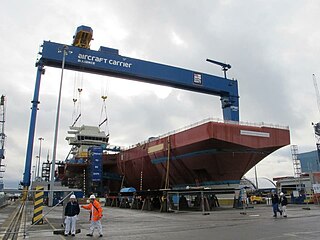
Goliath is a crane in Rosyth Dockyard, Scotland, with a lift capacity of 1,000 tonnes, the largest in Britain.

The Type 997 Artisan is a medium-range air and surface surveillance phased array 3D radar developed and built by BAE Systems for the United Kingdom's Royal Navy. It has been fitted to all 13 Type 23 frigates, HMS Ocean, HMS Bulwark, HMS Albion, HMS Queen Elizabeth and HMS Prince of Wales.
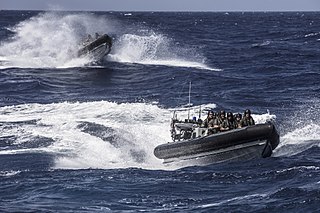
The Pacific 24 is a rigid inflatable boat made by BAE Systems in the UK, one of a range of small boats made by the company. As of 2020 it was the latest Pacific craft within the BAE Halmatic range, and has been proven in service with the UK MOD, UK police and overseas military and paramilitary organisations. It was designed to replace the Pacific 22. About 60 Pacific 24s are in service with the Royal Navy and Royal Fleet Auxiliary, including an uncrewed version of the boat which is controlled from a parent Navy ship or another location. This boat began tests in 2020 and a few such boats may ultimately be deployed for special missions.
SD Tempest is an ART 8032-class tug operated by Serco Marine Services in support of the United Kingdom's Naval Service. SD Tempest was ordered specifically to handle the Queen Elizabeth-class aircraft carriers. However, the vessel also performs general harbour towage when not required in her primary role.
The Future Offensive Air System was a study to replace the Royal Air Force's strike capability, at the time provided by the Tornado GR4. Initial operational capability was expected around 2017. The FOAS was cancelled in June 2005 and was replaced by the Deep and Persistent Offensive Capability (DPOC) requirement, which was itself cancelled in the 2010 Strategic Defence and Security Review.

